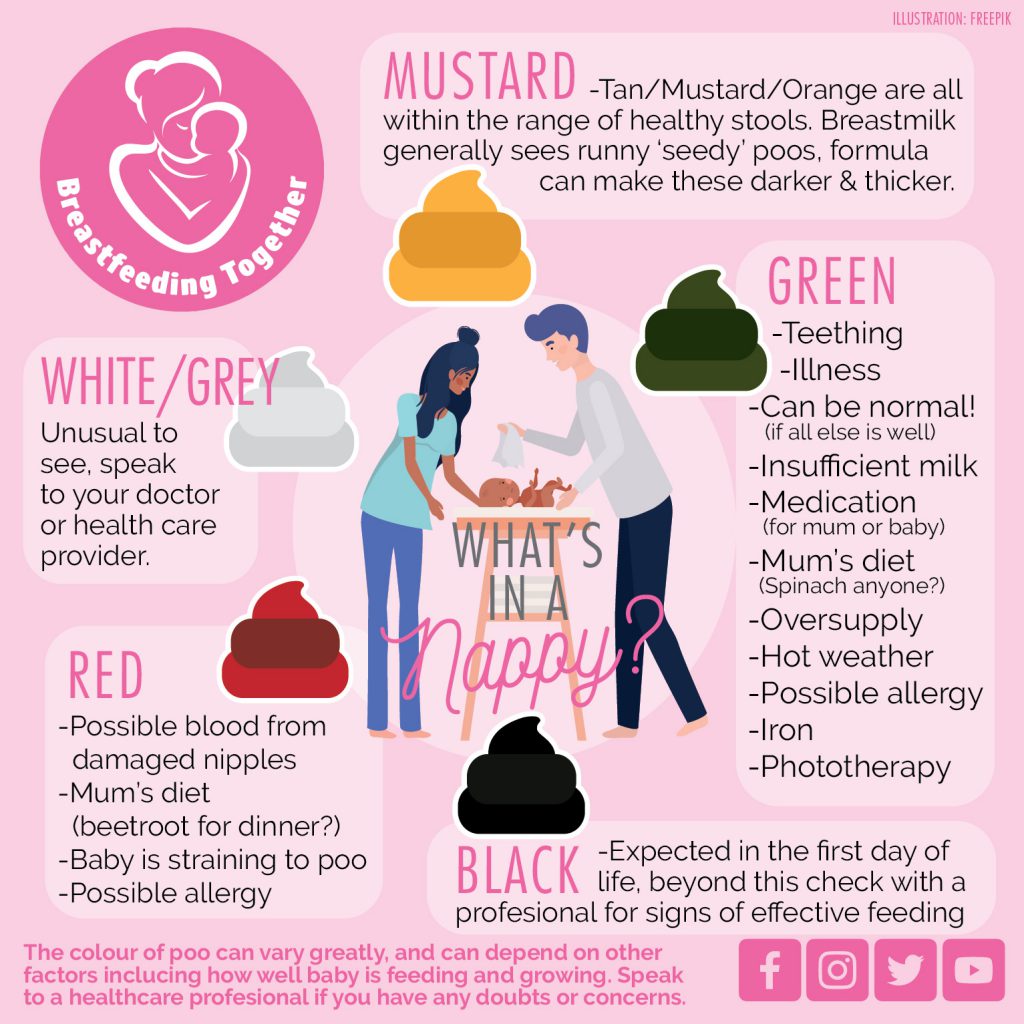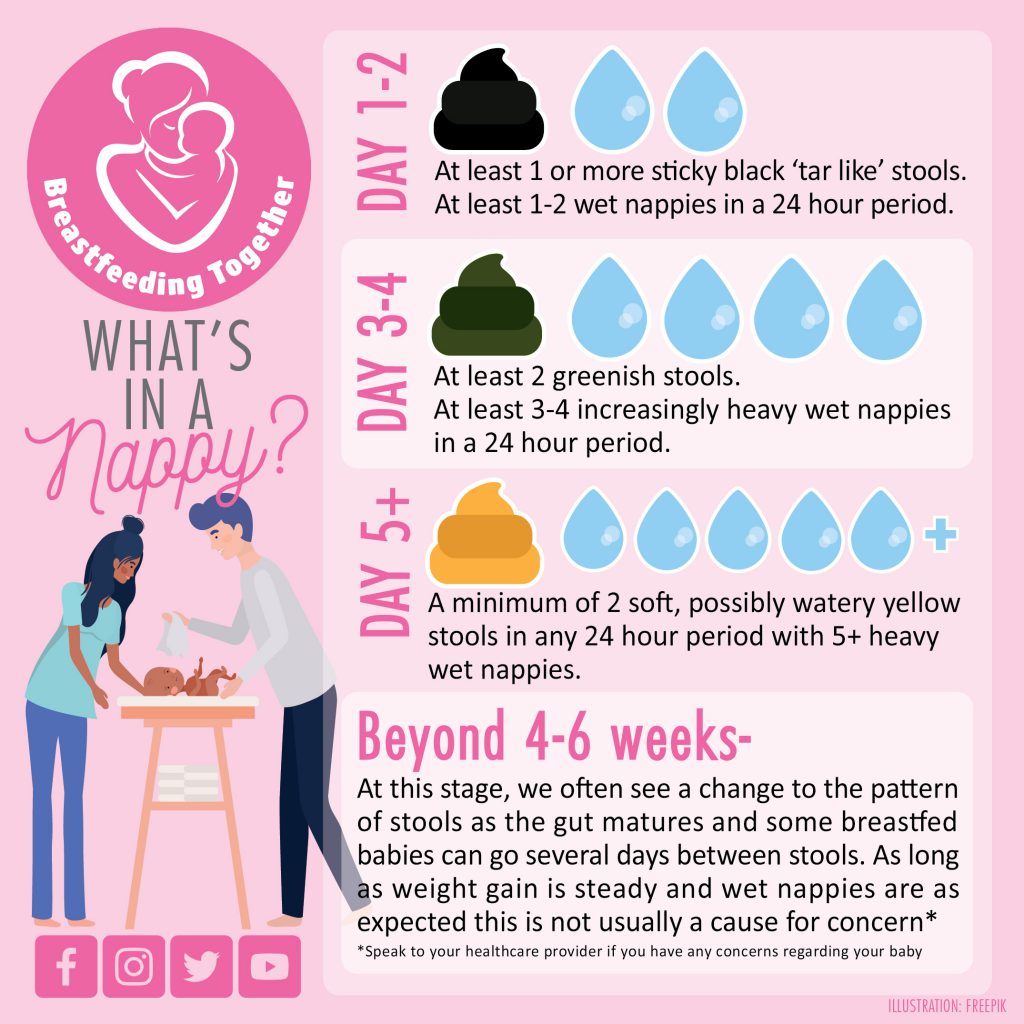
So we’ve already talked about what to expect in the early days and how newborn stools change in the first week or so of life, but beyond that we still get loads of questions asking about poo and what’s ‘normal’ particularly regarding colour! Like most things, what’s normal for one baby might be quite different for another, things can even change from day to day (even hour to hour!) and there is a veritable rainbow of colours which can all fall within the realms of what we would expect to see!
Yellow:
Or mustard, tan or orange are all typical for a breastfed baby who is feeding and pooing well! Often watery, perhaps with seedy bits- if it looks something like english mustard or a good old korma sauce you’re usually on the right track! In the first 4-6 weeks we’d be looking for at least a couple of £2 coin sized splats per day, but beyond this it can be a good few days in between as the gut slows down and becomes more efficient. As long as this runs alongside expected weight gain and effective feeding then it’s generally not a problem!
Green:
Green poos are one of the most common things we are asked about! A quick google can lead to all kinds of conclusions and can be enough to throw in a whole lot of confusion and maybe even a little panic, as there are so many varying suggestions!
Firstly it’s worth noting that if all else is well, baby feeds effectively and is gaining weight then an odd green stool isn’t usually anything to be concerned about, and for some babies it can even be normal to produce poos which are a little green in colour! There are also various other causes of green stools though, some more serious than others and if you have any doubts at all it’s worth looking into!
Teething, Illness or new medications for mum or baby are all things that can temporarily turn stools green. These all usually return to normal given a little time, but if you have any concerns speak to your GP or health visitor.
Mums diet- Another temporary one, but some foods can pass into breast milk colouring it and babys poo for a short while. As long as baby does not suffer any discomfort it’s not usually an issue and will right itself once that food stuff passes through.
Insufficient milk- If poo’s are also small, infrequent and baby seems unsettled and wanting to feed often it could be a sign that they are finding it difficult to feed effectively and fully drain the breast. As there can be various reasons for this, we’d suggest a full feeding assessment here by a breastfeeding specialist and additional support from your midwife, health visitor or a lactation consultant.
Oversupply- At the opposite end of the scale, too much milk can also be a problem! This can lead to plenty of foamy green stools and a windy unsettled baby as this is the result of taking in a greater amount of the lactose rich watery milk which we usually see at the start of a feed. This is often know as Lactose overload. With an oversupply, baby’s tummy can be filled with this before they reach the richer, fattier milk which tends to come a little later on. Again it’s best to seek help with this from breastfeeding support starting with a feeding assessment and tweaks to feeding to allow baby better access to the full range of milk and look at ways to reduce supply with care if required.
Hot Weather!- Similar to the case of over supply, when the weather is hot we often see babies taking shorter, more frequent feeds to stay hydrated which in turn means they again drink a higher proportion of that lactose rich watery milk. Result again is those foamy green poos. As the weather returns to normal, feeding patterns and poos tend to follow!
Allergy or Intolerance- Green poos can also be a sign of an allergy or intolerance to something in mums diet, but this will usually be accompanied by other symptoms such as an unsettled fussy baby, reflux, rashes or skin problems, colic, stuffy nose. As well as looking green, stools may also contain streaks of mucus and/or blood and may smell bad too! If you suspect an allergy or intolerance, it’s worth getting some extra support and starting with a full feeding assessment to rule out other causes. If an allergen is suspected then an elimination diet should help, but this should be done with additional support so discuss with your health visitor or a feeding specialist firstly.
Iron- Supplements for mum or baby can result in dark green stools whilst taking the medication.
Phototherapy- Can also result in temporary green poos during treatment for jaundice.
Oxidisation- A poo that’s been hiding in the nappy for a while can appear greenish due to oxidisation so this does not tend to be a reliable gauge of colour!
Black:
Black poos are expected on the first day or 2 of life, beyond this there could be various causes, we’d recommend a feeding assessment to check for signs of effective feeding and contact with your doctor or health visitor to rule out any issues.
Red:
Again, there can be a variety of causes here, and a few streaks of red are not always too much of an issue but again it’s well worth getting things checked with a medical professional to try and pinpoint a cause!
White or Grey:
It’s unusual to see pale stools like this, but they can be associated with liver conditions, so if you do find them speak to your doctor or healthcare provider for further investigation.
Like most things, the colour of a baby’s poo is just one part of a bigger picture! If you have any doubts or concerns, get in touch! We will help you work things out and point you in the right direction for additional support if you feel you need it….

